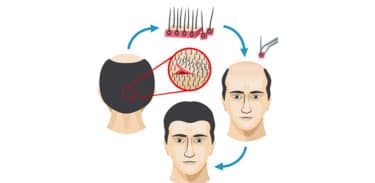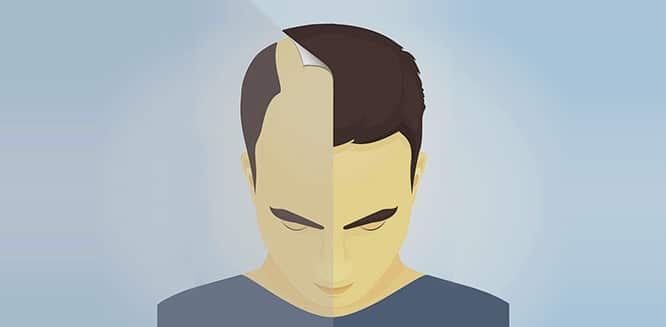FUT is one of the most modern hair transplantation methods which has been applied since 1990. This method is particularly recommended for people with larger bald areas. This method only needs a small surgical procedure, which strips from the donor area containing genetically stronger and non-falling hair are taken out. Then, under the microscope, the hair follicles are extricated from these strips and implanted in micro channels opened in the recipient area. Since the procedure is done with sedation, usually there is no pain, nevertheless a small amount of pain may develop after the procedure. Depending on the amount of hair follicles to be transplanted, one session may take 4 to 8 hours. After the stitched area is healed completely, additional sessions can be held.
Table of Contents
What is FUT hair transplant?
FUT (Follicular Unit Transplantation) is a hair transplant method in which hair follicles are implanted to the thinning areas by a small surgical procedure. In this method, hairy strips from the back of the head or the sides of the head, which are genetically strong, are cut out, and the hair follicles extricated from the skin strips with a minimal damage under the microscope are implanted one by one in the micro channels opened in the target area.
It is a highly recommended method for men and women who have larger bald areas on their heads. FUT can cost more reasonable since less labor and time is involved.
Benefits of FUT hair transplant
FUT results in the highest performance. If you want to achieve the maximum fullness, FUT should be your first option. There are various reasons for its success, such as microscopic separation of follicular units from the skin strips or cutting hair strips from a more efficient area, etc.
Among the most important advantages are:
- Donor area is not shaved.
- Up to 4000 hair follicles can be transplanted in one session. Several sessions may be required depending on the size of bald areas.
- The risk of damage to the hair follicles during collection from the donor area and processing is minimum.

The difference between FUT and FUE
The essential difference between FUT and FUE methods is how hair follicles are removed from the donor area: In FUT, the hair follicles are cut in the form of skin strips from the donor area with a small surgical procedure, whereas in FUE, the hair follicles are pulled out one by one without any incision.
Advantages of FUT hair transplant
- FUT’s session times are much shorter than the FUE’s, depending on the number of hair follicles to be transplanted. For example, FUT requires 15-30 minutes to cut out hair strips whereas FUE needs 1-4 hours to pull out hair follicles one by one.
- In FUT, a higher amount of hair can be transplanted than in FUE, therefore FUT is more recommended to people with higher risk of balding.
- Hair root (graft) quality is higher in FUT. Hair follicles are more likely to be damaged during FUE compared to FUT (particularly in thin hair).
- In FUT, hair strip is cut out from the center of the donor area to maximize the yield of high-quality grafts. In the following sessions, after the wound gets healed, new hair strips can still be taken out by an incision to the same area. Only one linear scar remains, no matter how many times the procedure is repeated. In FUE, follicular units are collected from a larger area in order to have a sufficient number of hair follicles. And in additional sessions, when new traces are added to the existing white spotsthey can distort adjacent units, which makes subsequent sessions more difficult (as hair in the donor area is reduced). Moreover, thinning may begin in the upper and lower parts of the donor area.
- FUT is more affordable than FUE, because it is less labor-intensive and time-consuming.
Disadvantages of FUT hair transplant
- In FUT, first, wounds in the donor area should be healed completely (it may take several months) in order to continue with subsequent sessions. Because FUE is a method without a surgery, following sessions can be done with 1 or 2 days intervals.
- Because FUT is a surgical method, it may cause more pain or loss of tissue sensation comparing to FUE.
- FUT surgery may leave a mid-size linear trace in the donor area. In FUE, only when the head is shaved, white spots can be seen.
- Recovery time of FUT is about 1 month. During this period, comparing to FUE, FUT may cause more discomfort aftermath and scalp may turn red for a few weeks.

Combined use of FUT and FUE methods
- In order to maximize the efficiency of hair follicles for the transplantation, first, FUT may be preferred. However, in following sessions, FUE technique may be employed, because the scalp might have tightened or the scars on the donor area might have enlarged more than expected. The surgeon may choose FUE in order to collect follicular units and use them to cover the expanding scars.
- If FUE is applied first, and the outcome is lower than expected, the patient may consider FUT for the remainder of this procedure or for subsequent operations.
Both FUT and FUE are successful, but both have different clinical implementations. Surgeons should have specializations and experience in both methods for a better result. The most convenient method is chosen by surgeons considering patient’s own personal choices.
Doctors help patients to make a decision based on the classification of hair loss, the size of balding-thinning area, the quality and the quantity of donor hair.
Who can benefit FUT?
Any healthy man or woman with sufficient hair to be transplanted, who has a scar due to androgenetic alopecia (male and female type baldness) or accidents such as burn, and is older than 20 years old.
FUT hair transplant procedure
A customized hair plantation plan is made according to the patient’s profile after his health is examined and his hair is analyzed. FUT method is implemented as follows:
- After the donor area is given sedation, hair strips are cut out in the form of thin, long rectangles as much as the amount of hair follicles needed. (Only the area where strips are cut out are trimmed, which is not noticeable.)
- The area where the strips are cut out is aesthetically stitched and bandaged to make sure that new hair grows along the scar.
- The donor strips are cut into separate follicular units and treated under microscopes; their natural forms are preserved in a special solution.
- After the recipient area is anesthetized, micro canals of 0.7-1 mm wide are opened to implant the hair follicles. While opening up these channels, the customized hair transplantation plan is followed, and factors such as the direction or distribution of the hair are considered.
- Hair follicles are implanted one by one with medical tools such as pliers etc. into micro channels in the recipient area.
- Last, a disinfecting solution is gently applied to the scalp to avoid infections.
Patient can go home on the same day. Recovery period is 10 to14 days. Most patients return to work 3 days after hair transplant.
How long does FUT hair transplant take?
It usually takes 4 to 8 hours, depending on the number of hair follicles to be transplanted. If the area concerned is large, more sessions may be required every few months.
When does hair grow after FUT hair transplant?
- Bandage is usually taken out a few days after surgery. Hair should be gently washed by hand.
- Sutures are removed after a few weeks. At the same time, the transplanted hair usually falls out and then grows again.
- New hair begins to grow naturally after 6 months.
- Hair reaches full maturity in terms of color, volume and fullness after 12 to 18 months.
Suggestions about FUT hair transplant
- Make sure you sleep in a half-sitting position after the operation. This will reduce swelling, and will prevent you from touching accidentally the area where hair follicles are implanted.
- Avoid touching, scratching and rubbing the area where hair follicles are implanted.
- Some doctors may ask you to shampoo your hair gently the day after surgery. Follow your doctor’s instructions.
- Take your prescribed medications (antibiotics and painkillers) regularly.
- Avoid smoking and alcohol for two weeks after surgery.
- Cover your head or wear a hat in order to avoid being in a direct contact with UV rays.
- Avoid strenuous activities like heavy exercises for about a month.
You should pay attention to your hair for 14 days after the operation. The transplanted grafts will not be strong enough in their new place. You can return to your normal hair care routine after 14 days.
Risks of FUT hair transplant
FUT is usually a safe procedure, but there is always a small risk as with any surgical intervention. The most common are:
- Excessive bleeding
- Swelling or bruising
- Infection
- Allergic reaction to anesthesia
Other less common risks are that:
- Transplantation has to stop.
- Existing hair in the recipient area falls down due to the shock of the procedure (usually hair fall is temporary, but sometimes permanent)
- An obvious scar remains.
Contact the operating clinic as soon as possible if there is any severe pain or an unexpected symptom.




